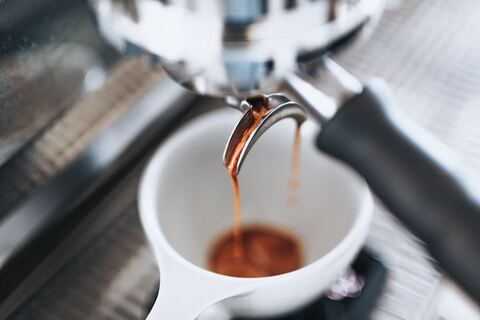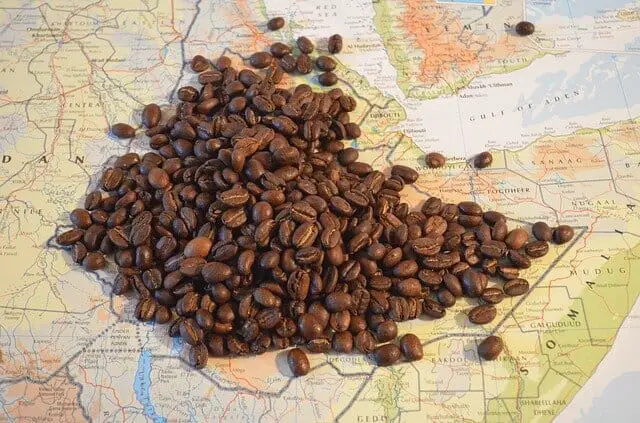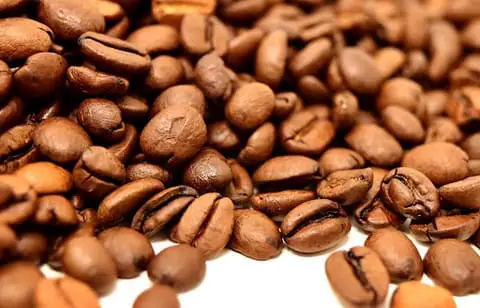As an Amazon Associate I earn from qualifying purchases. When you use our links, we may earn an affiliate commission. Learn more.
If you’ve ever wondered about the art of espresso and what goes into crafting the perfect shot, you’re in the right place. One common question I get from my readers is: Can you use regular coffee beans for espresso?

In this article, I’ll share my journey into the world of coffee beans. I’ll uncover whether or not you can use your go-to coffee beans to craft that rich, bold espresso you crave.
So, grab your favorite mug. Fill it with a delicious brew, and join me as we embark on this caffeinated adventure together!
Can You Use Coffee Beans For Espresso Shots?

While you can use regular coffee beans for espresso, you may get a different bold, intense taste than is characteristic of espresso made with beans specifically chosen and roasted for this purpose. If you enjoy experimenting with different flavors and don’t mind a milder espresso, I encourage you to try using your favorite coffee beans and see how the resulting espresso tastes.
Remember, the key lies in finding the right beans, roast level, and grind size to suit your preferences.
What Kind Of Coffee Beans Are Used For Espresso?
There isn’t a one-size-fits-all answer, as the choice of beans largely depends on individual preferences.
The most common types of coffee beans used for espresso are single-origin beans, blends (especially those that combine Arabica and Robusta), and dark-roasted beans.
This free cheat sheet will improve your coffee brew by providing quick information on brew ratio, grind size, optimal brewing time, and more.
Coffee Beans vs. Espresso Beans
First, let’s define coffee beans and espresso beans.
Coffee beans are seeds from the Coffea plant. They are roasted, ground, and used to brew various coffee beverages.
On the other hand, espresso beans are coffee beans specifically chosen and roasted for brewing espresso.
Now, let’s explore the main differences between the two.

Coffee beans come in a wide range of roast levels, from light to dark. Espresso beans are typically roasted darker, resulting in a bolder, more intense flavor profile.
Additionally, espresso beans are often ground finer than regular coffee beans. This finer grind is crucial for the high-pressure extraction process of making espresso shots.
So, are coffee beans and espresso beans the same? In short, espresso beans are a subset of coffee beans.
All espresso beans are coffee beans, but not all are ideal for making espresso. It ultimately comes down to the bean selection, roast level, and grind size.
The Importance Of Bean Type: Arabica And Robusta
Now, let’s talk about the two main species of coffee beans: Coffea Arabica and Coffea Canephora (more commonly known as Robusta).
Arabica beans are known for their delicate, nuanced flavors and lower acidity. They comprise about 60-70% of the world’s coffee production.
On the other hand, Robusta beans are more robust (hence the name) and have higher caffeine content. They’re known for their more potent, bitter taste and are often used in blends to add body and crema to espresso.
In commercial coffee production, Arabica is typically considered the higher quality bean, while Robusta is more cost-effective due to its resistance to pests and higher yield.

However, both Arabica and Robusta beans have their place in the espresso world.
When it comes to espresso, a blend of Arabica and Robusta beans is often preferred.
The Arabica beans contribute their delicate and complex flavors, while the Robusta beans provide the bold, strong taste and thick crema that espresso lovers seek.
Combining the strengths of both bean types allows you to achieve a well-balanced and flavorful espresso shot.
Using Coffee Beans For Espresso Shots
When considering regular coffee beans for espresso, you must understand that you might achieve a different level of bitterness and intensity typically associated with espresso shots.
This is because regular coffee beans may be roasted lighter and ground coarser than the best espresso beans, which can result in a milder, less concentrated flavor.
What Kind Of Coffee Beans Are Used For Espresso?
When it comes to choosing coffee beans for espresso, there are a few common types that are often used. Honestly, I love all three of these for different reasons and I strongly encourage you to experiment and test different varieties to see what works best for you!
- Single-origin beans: These beans come from a specific region or country, and their flavors reflect the unique characteristics of the local soil, climate, and processing methods. Single-origin beans can be an excellent choice for espresso if you’re looking for a distinct flavor profile that highlights the terroir of the beans.
- Blends: As mentioned earlier, a blend of Arabica and Robusta beans is popular for espresso. Blends combine the qualities of different beans to create a well-rounded and balanced flavor. They can offer the best of both worlds, with the complex flavors of Arabica beans and the strength and crema of Robusta beans.
- Dark-roasted beans: Espresso beans are typically roasted darker than regular coffee beans. This dark roast helps to bring out the bold, intense flavors and rich crema that are the signature of espresso. Look for beans labeled as “espresso roast” or “dark roast” if you’re after that classic espresso taste.
Espresso Roasting Techniques
Some notable differences exist between the techniques used for roasting espresso beans and those used for regular coffee beans.
A. Differences in roasting techniques
| Aspect | Espresso Beans | Regular Coffee Beans |
|---|---|---|
| Roast Level | Typically darker roast for bold, intense flavors | Varying levels (light to dark) depending on desired flavor profile |
| Roasting Time | Longer roasting time for intense flavors, uniform color, and smoother taste | Usually shorter compared to espresso beans |
| Roasting Temperature | Often roasted at higher temperatures for rich, dark color and bold flavor | Roasted at lower temperatures compared to espresso beans |
How The Roasting Process Affects The Flavor And Quality Of The Espresso
The roasting process plays a crucial role in determining the flavor and quality of the espresso. A few key ways the roasting process can affect espresso include:
- Flavor development: The darker roast used for espresso beans helps develop bold, intense flavors unique to espresso. This includes the caramelization of sugars and the development of bittersweet notes that contribute to the rich taste of the final product.
- Body and mouthfeel: The longer roasting time and higher temperature for espresso beans result in a fuller body and a more velvety mouthfeel in the brewed espresso. This is due to the breakdown of cellular structures in the beans, allowing for a smoother extraction and a more concentrated flavor.
- Crema formation: One of the hallmarks of a good espresso is a thick, golden crema on top. The dark roasting process used for espresso beans promotes the release of oils and gases during brewing, which helps create this desirable crema layer.
Tips For Achieving The Best Extraction With Coffee Beans For Espresso
This is something I’ve been working on a lot over the past few weeks and I can honestly say I’ve seen significant improvements in the quality, consistency, and flavor profile of my espresso shots. Here are a few useful tips to help you in your own coffee journey 🙂
- Invest in a quality grinder: A consistent, fine grind is essential for brewing a great espresso. Invest in a burr grinder, preferably one with multiple grind settings, to ensure that your coffee beans are ground evenly and the appropriate size for espresso.
- Measure and adjust: When preparing espresso, measuring the coffee grounds, water used, and extraction time is essential. Use 18-20 grams of coffee grounds for a double shot and aim for 25-30 seconds of extraction time. Adjust the grind size, dose, and extraction time to achieve your desired flavor profile.
- Tamp evenly: Tamping the coffee grounds into the portafilter is crucial for consistent extraction. Apply even pressure when tamping to create a uniform bed of coffee grounds, ensuring the water flows through the grounds evenly, extracting the flavors consistently.
- Keep your equipment clean: Regularly clean and maintain your espresso machine and grinder to ensure that they perform optimally. A buildup of coffee oils and residue can affect the taste of your espresso and the efficiency of the brewing process.
- Experiment and adjust: There’s no one-size-fits-all formula for the perfect espresso. Feel free to experiment with coffee beans, roast levels, grind sizes, and brewing techniques. Make adjustments as needed, and enjoy the process of discovering your ideal espresso.
Recommendations For Home Baristas
Brewing espresso at home can be a rewarding experience, and finding the right beans is an essential part of the process. Here are some tips and recommendations to help you select the best coffee beans for your home-brewed espresso.
Tips For Selecting Coffee Beans For Espresso At Home
When choosing coffee beans to use with my Breville Barista Express machine at home, there are a few things I always think about. I love nothing more than finding a delicious blend from a local coffee roaster:
- Consider your taste preferences: Consider the flavors you enjoy in your espresso, such as fruity, chocolatey, or nutty notes. This will help guide your choice of beans, as different beans can have a wide range of flavor profiles.
- Experiment with blends and single-origin beans: Be bold and try blends and single-origin beans to see which you prefer. Blends offer a balanced, well-rounded flavor, while single-origin beans showcase unique characteristics from their specific region.
- Pay attention to roast dates: Freshly roasted beans are critical to excellent espresso. Look for beans with a roast date within the past two weeks to ensure optimal flavor and freshness.
- Buy from a reputable roaster: Purchase your beans from a reputable roaster or specialty coffee shop. They are more likely to provide high-quality beans and have knowledgeable staff to guide your selection.
Recommended Brands Or Bean Types For Espresso Enthusiasts
Here are five incredible coffee brands that I’ve personally tried and loved, you can click the links below to find out more about each of them. Enjoy!
- Blue Bottle Coffee: Known for its high-quality beans and commitment to freshness, Blue Bottle Coffee offers an excellent selection of blends and single-origin beans suitable for espresso.
- Intelligentsia Coffee: This well-respected roaster provides a range of espresso-friendly beans, including their popular Black Cat Classic Espresso blend, which combines sweetness, acidity, and body for a balanced flavor profile.
- Lavazza Super Crema: A popular choice among espresso enthusiasts, Lavazza Super Crema is a blend of Arabica and Robusta beans that delivers a rich, velvety crema and a smooth, balanced taste.
- Stumptown Coffee Roasters: Known for their commitment to quality and sustainability, Stumptown offers a variety of espresso-friendly beans, including their Hair Bender blend, which features a sweet, complex flavor profile.
This free cheat sheet will improve your coffee brew by providing quick information on brew ratio, grind size, optimal brewing time, and more.


